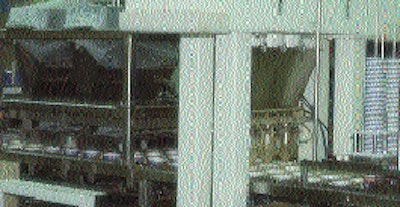As the demand for high-quality, all natural vegetarian convenience foods grows, supermarkets have joined health food stores in promoting such products. That spells opportunity for firms like Fantastic Foods, and the Petaluma, CA, firm has been anything but shy about seizing it. In March of 1994, it had high-powered design firm Primo Angeli (San Francisco, CA) create a new brand identity for its 60-item line. At about the same time, it added a second packaging line for its all-natural instant soup cups, now available in 23 flavors. "When the new cup line went in, the plant was capable of 60ꯠ to 70ꯠ 12-count cases of soup cups per month," says chief executive officer Jim Smith. "We redesigned it to produce a half million cases per month on two shifts." The added capacity comes not only by way of the new line. The company also upgraded the original soup line significantly. Smith and company had little choice. The groundswell of demand in the mainstream marketplace has meant increasingly larger orders from national supermarket chains including Safeway, Albertson's and Wegman's. The new packaging line features a four-up volumetric filler from AMS filling systems (Malvern, PA) and two fillers designed by Smith and manufactured locally. All three are mounted above a dispensing/conveying/lidding system from Autoprod (Clearwater, FL). The AMS system is responsible for the powdered spice blend that goes into each cup. The second filler is used for dehydrated vegetables, and the third is used if noodles are among the ingredients. At 144 cups/min, the line is not lightning fast. But considering that the cups must stop at three successive filling stations, the speeds are impressive enough. Bulk handling Powdered spice blends and dehydrated vegetables are delivered to the first and second filling stations respectively by a bulk ingredient system from Flexicon (Phillipsburg, NJ). It consists of two bulk bags, one for spice blends and one for veggies, feeding two stainless steel hoppers that use auger screws to send product down through feed tubes to the filling stations on the Autoprod system. Level sensors in the hoppers at the filling stations signal when more product is needed. The bulk bag/bulk hopper arrangement ensures a constant supply of both spices and dehydrated vegetables. When the bulk bag empties the last of its contents into the bulk hopper, there's enough product in the hopper to keep the cup-filling line running until a fresh bag can be brought in. Right below these large hoppers is the beginning of the packaging line. A screw dispenser places four of the attractively decorated paper cups in the four-across pockets of the Autoprod system, which indexes the cups beneath the three filling stations. The cups are supplied by two vendors, but that should change late this year, says Smith, who expects to be making his own containers on-site. "In-house production is so cost-effective it isn't funny," he says. "We now pay almost six cents per cup. I can make them for two cents. And with the technicians we have we can make them just as well." When it came to selecting fillers, Smith was satisfied that the Model A-300-4 from AMS would efficiently and accurately handle spices. But the other dispensers were designed in-house. "As long as we were developing the software governing how much product drops into each cup, we felt it would make the most sense to also design the equipment according to the software we developed," says Smith. The four fill spouts of the AMS system are auger-driven. The amount of product dispensed is a function of the number of turns the auger screw makes. But the next two filling stations are net weight fillers that work like this. Transfer onto load cells As cups approach the station, they ride up a slight incline so that when they pause for filling they no longer are held by the rolled lip of the cup. Instead, each rests on a load cell. Product, meanwhile, has been vibrated down from the overhead hopper and divided into four chutes positioned horizontally, one above each cup. As soon as the cups come to a halt on their load cells, a signal tells the chutes to vibrate. As they do, product drops into the cups. When each load cell determines that the proper weighment has been released, the chutes cease vibrating. The cups then index forward to the next filling station. The third filling station differs from the first two in that its hopper is fed by a bucket elevator, wheeled into place when needed, instead of a feed tube from the Flexicon system. The dry, crispy noodles handled by this hopper are too fragile for an auger-based automated feed system like Flexicon's. Total gram weight of product in the cup depends on what ingredients are included. But when consumers reconstitute the ingredients by adding hot water, a 15-oz serving is what they get. Smith is proud of the filling system he developed, which is accurate, he says, to within ±0.5 g. "That kind of accuracy has not been achieved in this business before," says Smith. And it's not just the new line that hits those targets. The upgrades done to the original cup line make it capable of the same accuracy at the same throughput. Before the upgrade, accuracy was within ±10 g. Once all product has been dispensed, the cups are indexed to the lidding section of the Autoprod system. Here vacuum cups pluck four precut paper lids from magazine feeds and place them over the filled cups. Four small metal protuberances keep the lid in the proper alignment as the cups are indexed into the heat-seal station about 12" away. Heat seal and discharge As soon as cups are in the heat-sealing station, four sealing tools come down and settle neatly over the lids. After sealing, the cups are pushed up out of their cavities and swept forward to a conveyor that takes them away at a right angle. At this point, the four-abreast cups have been transformed into a single row of cups. Metal detection and checkweighing is performed on two units supplied by Ramsey Technology (Minneapolis, MN). Following the Ramsey devices is a Domino Amjet (Gurnee, IL) ink-jet printer that imprints lot number and product expiration date on the lid. Case packing is next, though not before the single row of cups has been diverted into two rows. This is accomplished by the case packer's gating mechanism, which swings back and forth from one lane to another. It also incorporates a clever braking device. Pneumatically powered, the device comes down on top of the cups and holds them momentarily during the split second it takes the diverter to swing from one lane to another. Consequently, there is no chance for cups to get hung up. They're only free to move forward when there's a clear lane to move into. The case packer, model MPV-350, was supplied by Wepackit (Orangeville, Ontario, Canada). It has four heads, each equipped with six vacuum pick-up cups. Its cycle begins when enough cups have entered to fill both lanes. The heads descend, pick up cups, rise, and then move toward the waiting cases. As they do so, each head moves laterally a few inches so that when the heads drop down into the cases, they've been separated from each other enough to ensure that no cup is being dropped onto the edge of a case. The Wepackit machine is responsible only for loading cups into cases. Case erection is done by a nearby unit supplied by Loveshaw (Ronkonkoma, NY). A case taper from the same firm finishes cases as they leave the case packer. Finally, a Domino Amjet ink-jet coder applies product name, lot number and 15-mo best-if-used-by date. Palletizing is done outside the packaging room. "We aim for long runs, but if we have to, we can change to a new product three or four times in a shift," says Smith. Yet it isn't the line's flexibility that most impresses Smith. It's the consistency. "On a 10ꯠ-cup run, we have less than 50 cups rejected," says Smith. "To me that's efficient filling."





























